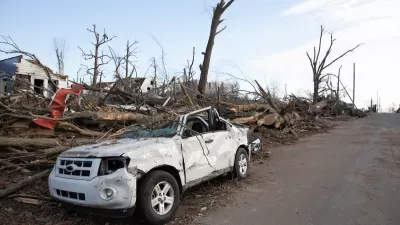Hurricane Sandy exposed the need for New York City to be able to house large numbers of residents following natural disasters. Matt Chaban examines the Bloomberg administration's "secret" plan to build modular apartments out of shipping containers.
"When the next storm of the century hits, thousands of shipping container apartments could be arriving in the city within days," writes Chaban. The Bloomberg administration has been developing a "first-of-its-kind disaster housing program" that will consist of "a 480-square-foot one-bedroom apartment carved out of a 40-foot-long shipping container." The bedroom would be equipped with amenities like a bed, dress, nightstand and lamp; the living-dining room with a couch, table and chair; the kitchen with pots, pans, china and flatware; and a bathroom with clean towels, soap, toothbrushes and toothpaste. For larger families, additional bedrooms and bathrooms could be attached. "It's nicer than my apartment," said David Burney, commissioner of the Department of Design and Construction. Each module is estimated to cost between $50,000 and $80,000, and the Federal Emergency Management Agency is expected to cover most of the costs.
The ability to stack shipping containers "creates a level of density that is inherently, and necessarily New York." The city is also considering adding retail and community spaces on the ground floor. “We’re not just restoring somebody’s apartment, we’re restoring somebody’s street,” said Thaddeus Pawlowski, an urban planner at the Department of City Planning. “New Yorkers love their streets. They love their neighborhoods. So it’s very important people feel connected again to their neighborhood.” The city chose to use shipping containers based on a number of proposals submitted to their contest What If NYC for long-term disaster housing ideas. One criteria was that the solution must "maximize the ability of New Yorkers to feel a sense of identity and even pride in where they live." The city has been closely working with Sea Box on the project, reports Chaban, but issues like zoning codes and the American's Disabilities Act had to be addressed before moving forward. A plan being considered would involve producing 15,000 reusable units for the first one to two months after a disaster, and then producing more as needed. "Following the program, they would be broken down, retrofitted and put back into storage for the next disaster."
"While the program has been built with New Yorkers in mind," says Chaban, "City Hall believes it could serve as yet another model for cities around the country." $1 million was obtained to build a 16-unit prototype behind the headquarters of the New York City Office of Emergency Management, but all resources have now been directed towards Sandy relief efforts. "Even so, the administration still plans to have a prototype deployed by the second half of next year - and if anything, Sandy has made that goal more urgent, not less."
FULL STORY: Home, Sweet Shipping Container: NYC’s Secret Plans for the Perfect Disaster Apartments

Alabama: Trump Terminates Settlements for Black Communities Harmed By Raw Sewage
Trump deemed the landmark civil rights agreement “illegal DEI and environmental justice policy.”

Study: Maui’s Plan to Convert Vacation Rentals to Long-Term Housing Could Cause Nearly $1 Billion Economic Loss
The plan would reduce visitor accommodation by 25% resulting in 1,900 jobs lost.

Planetizen Federal Action Tracker
A weekly monitor of how Trump’s orders and actions are impacting planners and planning in America.

Restoring Northern India’s Himalayan ‘Water Temples’
Thousands of centuries-old buildings protect the region’s natural springs and serve as community wells and gathering places.

Milwaukee to Double Bike Share Stations
Bublr Bikes, one of the nation’s most successful, will add 500 new e-bikes to its system.

DC Extends Application Window for Outdoor Dining Permits
District restaurants will have until the end of November to apply, but businesses with permits in rush hour parking lanes must end operations on July 31.
Urban Design for Planners 1: Software Tools
This six-course series explores essential urban design concepts using open source software and equips planners with the tools they need to participate fully in the urban design process.
Planning for Universal Design
Learn the tools for implementing Universal Design in planning regulations.
Caltrans
Smith Gee Studio
Institute for Housing and Urban Development Studies (IHS)
City of Grandview
Harvard GSD Executive Education
Toledo-Lucas County Plan Commissions
Salt Lake City
NYU Wagner Graduate School of Public Service




























